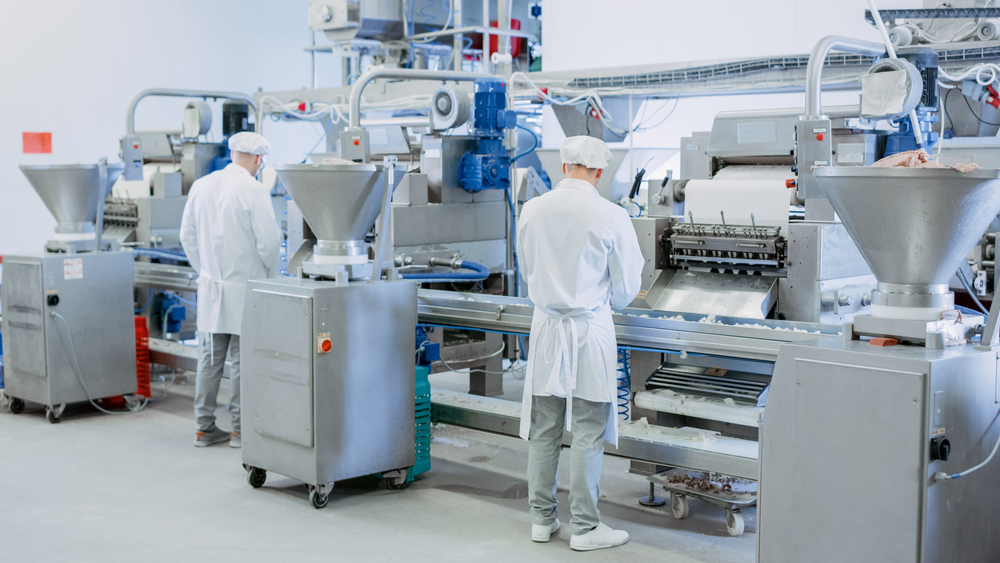Food Processing Equipment Sanitation: Why is it Important?

Food processing sanitation equipment has become a vital and necessary operation through the food industry. In 2021 alone, there were 47 product recalls that resulted in 15,501,273 pounds of food being sent back to the manufacturers, according to the USDA Food Safety and Inspection Service. Some reasons for the recalls were due to dangerous bacteria and extraneous materials being found in the processed food.
Types of bacteria found included Salmonella (1,119,074 pounds recalled), Listeria monocytogenes (11,281,291 pounds recalled), Shiga toxin-producing E. coli (300,096 pounds recalled), and Bacillus cereus (10,990 pounds recalled). About 984,554 pounds of food were recalled due to extraneous materials.
Food and beverage companies adopting Good Manufacturing Practices (GMP) will have sanitation standard operating procedures (SSOPs). SSOPS are documents which detail the required procedures to safely clean and sanitize surfaces and equipment which come in contact with food. Learn more about these cleaning and sanitizing procedures and how spray solutions offer coating, cleaning, washing, and sanitizing solutions for various work processes.
Cleaning and Sanitation Procedures for Food Processing Equipment
Food processing equipment sanitation involves taking steps to both clean off contaminates and sanitize surfaces. The procedures may vary slightly depending on whether the equipment is used in a wet or dry food processing environment. Streamlining these processes with the latest spray and cleaning technologies can help eliminate possible bacteria and foreign contaminants from entering production processes.
The first step is to remove visible debris and soil deposits using a lint-free cloth, brushes, scrapers, and dry floor push mops. Vacuuming and low-moisture steaming may also be used to remove soil deposits. Soil deposits may involve lubricants, residues, large particles, gross particles, and other substances.
Rinsing becomes the second step before the cleaning and sanitizing. This step is usually reserved for wet food processing as dry-cleaning methods are used for dry food processing equipment. Using rinsing for dry food processing equipment may introduce mold and bacteria growth into food. Rinsing should be done with low pressure hose and spray equipment using warm but not hot temperatures -- around 120°F. Warmer temperatures may cause particles to stick to processing equipment and make them harder to remove.
Chemical cleaners and scrubbing are now performed on equipment. Detergents should be diluted and used at the appropriate concentrations to ensure the surfaces are clean without endangering workers. For dry processing equipment that receives occasional wet cleanings, the equipment should be disassembled and taken to the appropriate washing area. Cleaning chemicals and water should become applied as the parts need to be thoroughly rinsed and dried before returning to the dry food processing work area for reassembly.
Once surfaces are clean of residues and particles, the equipment undergoes another rinse before the sanitizing stage. This final rinse removes any remaining detergent and cleaners from surfaces. Equipment is visually inspected to look for any remaining contaminants or detergents in hard to reach areas and crevices in the equipment. Workers then apply sanitizing chemicals. Equipment will undergo a final rinsing for sanitizing chemicals that must be washed off before undergoing a drying process.
Using specially designed spray nozzles can improve this process, as the nozzles are designed to ensure maximum spray coverage of rinse water and diluted detergents for all equipment surfaces. The cleaning nozzles are also designed to apply sanitizing chemicals for both equipment used for wet food processing areas and when spraying on alcohol-based products for dry processing facilities. By using these systems, workers can quickly follow SSOP standards while placing the cleaned equipment, such as conveyors, tanks, and other machines, back online.
What's the Difference Between Cleaning and Sanitizing?
Cleaning and sanitizing should always be seen as two different methods in the food processing industry. Cleaning procedures are designed to remove visual contaminants and residues from surfaces. The cleaning strips off the dirt, debris, and organic materials off equipment.
Yet even when the surface looks clean, bacteria and microorganisms may remain. Sanitizing methods are designed to eliminate most bacteria and limit microorganism growth from surfaces. While not all bacteria or microorganisms will be removed, the sanitizing chemicals reduce the contamination levels until it is considered to be safe for human health.
One process should never supersede the other. Both are necessary to address both bacteria and other harmful contaminants. Cleaning removes the particles that become the breeding ground for bacteria. Sanitizing removes the bacteria.
What is the Purpose of Sanitizing a Food Contact Surface?
Food contact surfaces are any surfaces that food may touch. The surfaces may involve tables where food is cut, chopped, or processed, conveyor belts that move food, storage tanks, processing equipment, and containers that will hold the food or beverages before shipping. Sanitizing reduces the bacteria load on these surfaces until reaching safe levels.
Sanitizing products must be validated as being suitable for food industry food processing equipment sanitation by the U.S. Environmental Protection Agency's (EPA) Federal Insecticide, Fungicide, and Rodenticide Act (FIFRA). Sanitizers should not be confused with disinfectants, which are two different products. Sanitizing products kills bacteria at a faster rate than disinfectants, yet disinfectants have stronger chemicals to kill more bacteria.
Sanitization may occur before food contact surfaces are placed into use, after production processes end for the day, or during production if quality control determines that bacteria levels are above safety limits or extraneous materials have been found in food products.
Food Processing Equipment Sanitation Nozzles
Spray nozzles from Lechler may be used for both cleaning, rinsing, and sanitizing procedures for food and beverage industries. These technologies can be employed for production preparation surfaces, product processing equipment, and filling and packing processes.
We classify our nozzles under cleaning efficiency classes based on the soil type that may be present on surfaces. Our nozzles can provide light rinsing techniques, light soil removal, medium soil removal, heavy soil removal, and persistent soiled surfaces. Learn more about our spray technologies by contacting us today.